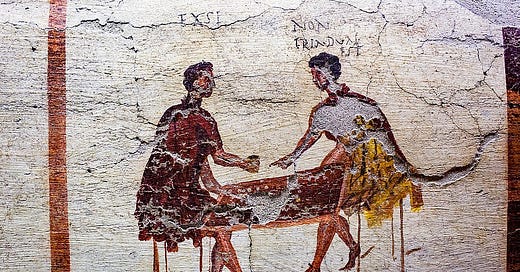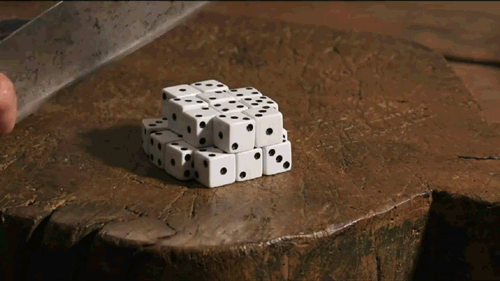Dice can mean lots of different things to different people.
If you’re a high roller and you want people to know you like to take risks, maybe you have a pair of fuzzy dice hanging from your mirror. You like to live on the wild side, don’t you? You wild card, you!
On the flip side, if you’re a dungeon master from the late 80s, you certainly don’t want people to associate you with those polyhedric omens. You didn’t exactly wear your character attributes on your sleeve back then.
As a character-sheet carrying member of team D&D, I became curious about the role of dice in ancient games. I already knew there were some shady games being played with dice during Elizabethan England, but that was as far back as my knowledge went.
I was therefore unprepared to discover that six sided dice have been in constant use for more than four thousand years in Ancient Egypt. There were board games back then already in existence, where simple pawns went around a board trying to get to the afterlife. At first, sticks were flipped over like a coin being tossed to introduce an element of randomness, but over time, six sided dice were introduced.
By the time of the Roman Empire, dice were in common use, as you can see from these two scoundrels from Pompeii:
Long before people were rolling dice, though, they were rolling bones.
All over the world, knuckle bones have been found among the remains of ancient cultures. Many of these have tally marks, just like a die, indicating a number for each side. Others have symbols on them, giving us a clue that maybe they weren’t used for games.
In fact, it’s more likely that dice (or these proto-dice made from animal bones) first cropped up entirely for supernatural or ritualistic purposes. Maybe the games using them were played for higher stakes than Monopoly money.
These astragali (knuckle bones) weren’t exactly six-sided, though. They were rounded at the ends with four relatively flat sides. It might have seemed appealing for someone to try to flatten those two rounded sides one day, or maybe someone just started from scratch with a fresh piece of bone or wood, but the familiar six-sided die was born.
It was during the Roman period that six-sided dice became somewhat standard, after eons of game play and divination, sometimes with both going on at the same time. Rome spread ideas far and wide over many centuries, and dice were certainly a part of this culture.
The cube-shaped die became easy to replicate as the tools used to make other tools got better, and before we knew it, six sided dice were the standard nearly everywhere.
There must have been incredible power in claiming to be able to tell the future from looking at something that once walked around. There was something about the living working with the dead (the bones) in order to get the answers that made sense to our prehistoric ancestors, or at least that’s what I’m deducing from all this.
I myself felt the power of those dice, but in a different sort of way. They would help me to tell a story as a dungeon master, where I would provide the framework for the characters to go on an adventure and they’d decide exactly what to do. And, in the fantasy realm of D&D, they provided the element of divination in their own way, deciding whether a character would live or die.
Did you play any dice-based games as a kid? Do you currently play D&D or any other games you might not have wanted everyone to know about back in the day?






So now I know where "roll the bones" came from- but whatever caused the dice game "craps" to get that name?
Many dice games as a kid. Made up quite a few of our own, esp when we came of pre-legal drinking age. :)